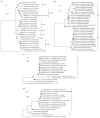Characterization of a triple-recombinant, reassortant rotavirus strain from the Dominican Republic
- PMID: 27983480
- PMCID: PMC5720362
- DOI: 10.1099/jgv.0.000688
Characterization of a triple-recombinant, reassortant rotavirus strain from the Dominican Republic
Abstract
We report the genome of a novel human triple-recombinant G4P[6-8_R] mono-reassortant strain identified in a stool sample from the Dominican Republic during routine facility-based rotavirus strain surveillance. The strain was designated as RVA/Human-wt/DOM/2013840364/2013/G4P[6-8_R], with a genomic constellation of G4-P[6-8_R]-I1-R1-C1-M1-(A1-A8_R)-N1-(T1-T7_R)-E1-H1. Recombinant gene segments NSP1 and NSP3 were generated as a result of recombination between genogroup 1 rotavirus A1 human strain and a genotype A8 porcine strain and between genogroup 1 rotavirus T1 human strain and a genotype T7 bovine strain, respectively. Analyses of the RNA secondary structures of gene segment VP4, NSP1 and NSP3 showed that all the recombinant regions appear to start in a loop (single-stranded) region and terminate in a stem (double-stranded) structure. Also, the VP7 gene occupied lineage VII within the G4 genotypes consisting of mostly porcine or porcine-like G4 strains, suggesting the occurrence of reassortment. The remaining gene segments clustered phylogenetically with genogroup 1 strains. This exchange of whole or partial genetic materials between rotaviruses by recombination and reassortment contributes directly to their diversification, adaptation and evolution.
Conflict of interest statement
Figures



Similar articles
-
Genomic characterization of G3P[6], G4P[6] and G4P[8] human rotaviruses from Wuhan, China: Evidence for interspecies transmission and reassortment events.Infect Genet Evol. 2015 Jul;33:55-71. doi: 10.1016/j.meegid.2015.04.010. Epub 2015 Apr 16. Infect Genet Evol. 2015. PMID: 25891280
-
Identification of circulating porcine-human reassortant G4P[6] rotavirus from children with acute diarrhea in China by whole genome analyses.Infect Genet Evol. 2013 Dec;20:155-62. doi: 10.1016/j.meegid.2013.08.024. Epub 2013 Sep 3. Infect Genet Evol. 2013. PMID: 24012957
-
Multispecies reassortant bovine rotavirus strain carries a novel simian G3-like VP7 genotype.Infect Genet Evol. 2016 Jul;41:63-72. doi: 10.1016/j.meegid.2016.03.023. Epub 2016 Mar 28. Infect Genet Evol. 2016. PMID: 27033751
-
Rotavirus G9P[4], G9P[6] and G1P[6] strains isolated from children with acute gastroenteritis in Pune, western India, 2013-2015: evidence for recombination in genes encoding VP3, VP4 and NSP1.J Gen Virol. 2019 Dec;100(12):1605-1630. doi: 10.1099/jgv.0.001323. J Gen Virol. 2019. PMID: 31553304
-
Full genomic analysis of a porcine-bovine reassortant G4P[6] rotavirus strain R479 isolated from an infant in China.J Med Virol. 2010 May;82(6):1094-102. doi: 10.1002/jmv.21760. J Med Virol. 2010. PMID: 20419827
Cited by
-
Emergency Services of Viral RNAs: Repair and Remodeling.Microbiol Mol Biol Rev. 2018 Mar 14;82(2):e00067-17. doi: 10.1128/MMBR.00067-17. Print 2018 Jun. Microbiol Mol Biol Rev. 2018. PMID: 29540453 Free PMC article. Review.
-
Evolutionary characterization and pathogenicity of the highly virulent human-porcine reassortant G9P[23] porcine rotavirus HB05 strain in several Chinese provinces.Front Microbiol. 2025 Mar 14;16:1539905. doi: 10.3389/fmicb.2025.1539905. eCollection 2025. Front Microbiol. 2025. PMID: 40160270 Free PMC article.
-
Intragenic recombination influences rotavirus diversity and evolution.Virus Evol. 2020 Jan 13;6(1):vez059. doi: 10.1093/ve/vez059. eCollection 2020 Jan. Virus Evol. 2020. PMID: 31949920 Free PMC article.
-
Uncovering the First Atypical DS-1-like G1P[8] Rotavirus Strains That Circulated during Pre-Rotavirus Vaccine Introduction Era in South Africa.Pathogens. 2020 May 20;9(5):391. doi: 10.3390/pathogens9050391. Pathogens. 2020. PMID: 32443835 Free PMC article.
-
Interspecies transmission of porcine-originated G4P[6] rotavirus A between pigs and humans: a synchronized spatiotemporal approach.Front Microbiol. 2023 May 22;14:1194764. doi: 10.3389/fmicb.2023.1194764. eCollection 2023. Front Microbiol. 2023. PMID: 37283926 Free PMC article.
References
-
- Estes MK, Greenberg HB. Rotaviruses. In: Knipe DM, editor. Fields Virology. Philadelphia, PA: Wolters Kluwer/Lippincott, Williams and Wilkins; 2013. pp. 1347–1401.
MeSH terms
Substances
Grants and funding
LinkOut - more resources
Full Text Sources
Other Literature Sources
Medical

